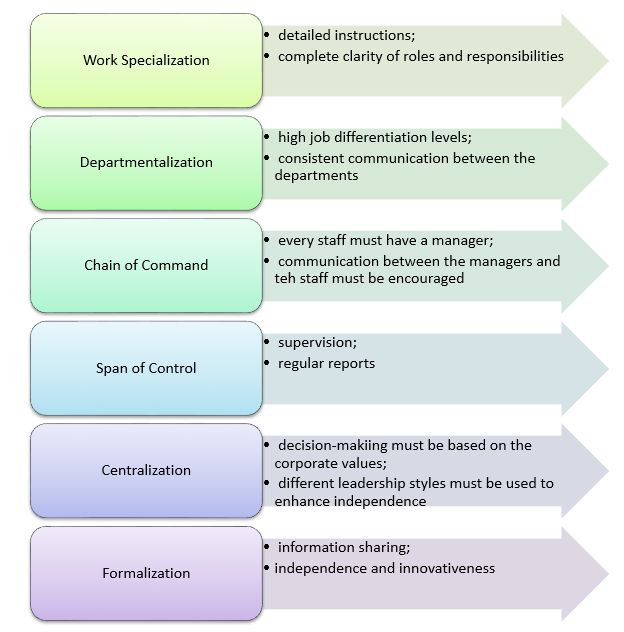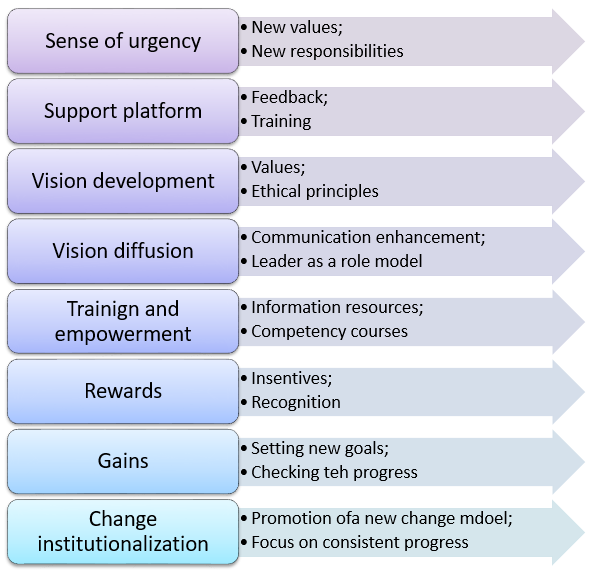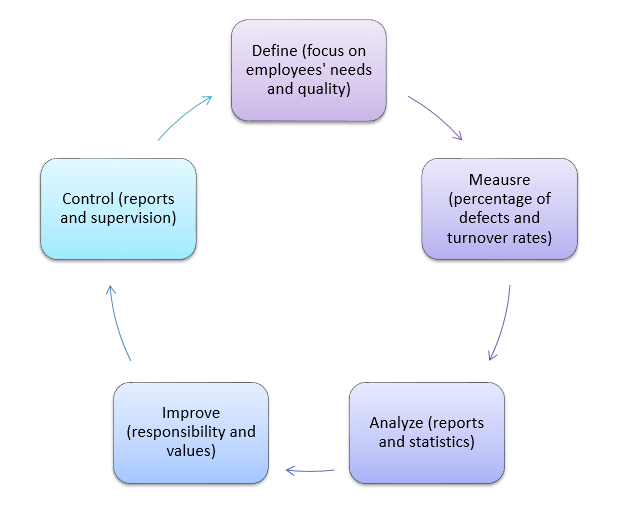Introduction
CMA has been experiencing the need to improve its performance to a considerable extent. However, it is expected that the alterations to the company’s design will trigger pushback among the staff members. Therefore, a heavy emphasis must be placed on the importance of the identified changes for the employees. Particularly, the opportunities that the new corporate standards will open in front of them will have to be emphasized and used as the means of enhancing engagement and motivation among the target population.
As a result, a significant increase in the product quality, as well as a drop in the number of defects, can be expected. Among the tools that minimize the discomfort experienced by the employees in the course of change implementation, one should mention the enhancement of the communication process, especially the emphasis on the active support that the staff members will receive from the company. As a result, a successful transfer to a new stage of relationships and quality management will become a possibility in the context of CMA.
Culture and Structure in the Context of an Organization: Definition
When carrying out the change, one will have to focus on the organizational culture and structure extensively since the two define the relationships between the staff members and, thus, predetermine their attitude to the change. Therefore, the issue of resistance and stress can be addressed successfully.
By definition, the organizational structure is viewed as the combination of the communicational tools and strategies used by its members in order to transfer the necessary information, share the relevant knowledge, and contribute to the production process (Wilson, 2014).
A closer look at the way in which the information transfer processes and communication, in general, are structured at CMA will reveal that there is a consistent lack of an efficient system of feedback acquisition and analysis, as well as the tools for information sharing among the employees working in different departments. The identified issue can be addressed by introducing the latest technological advances into the context of the organization. Furthermore, the significance of sharing information across departments as the basis for building a successful team must be promoted to all staff members. The new communication strategy must gear toward the following goals:
Accurate work specialization
Every single staff member must be provided with clear instructions about their new role, responsibilities, and tasks;
Departmentalization
Clear and measurable goals must be set for the company’s departments (Marketing, R&D, Production, and Finance). Furthermore, cooperation must be promoted among the members of the identified departments. For instance, the number of defects registered in the course of the production process will inform the R&D department about the areas on which the R&D team will have to work.
Efficient chain of command
Every staff member will be supervised by and accountable to the corresponding manager. Furthermore, the employees will receive directions from the managers regarding their tasks and responsibilities. Thus, further confusion about the changes in the roles of the employees will be avoided.
Control
Supervision will be used as the means of executing objective control over the staff. Daily reports will be submitted by the employees so that the managers could keep track of the key processes and identify the root cause of a problem, should one appear.
Balance between centralization and decentralization
The concept of innovation and consistent improvement will be promoted as the primary value of the organization. Furthermore, the employees will be encouraged to develop workplace responsibility. As a result, the decisions associated with the local processes will be made by the staff members, whereas global choices affecting the company will be made by the leaders and managers. For this purpose, not only the transformational leadership style but also the laissez-faire approach will have to be deployed. Hus, the employees will be able to develop the necessary independence (Jex & Britt, 2014).
Formalization process enhancement
While formalization should be encouraged to make sure that every bit of company-related information should be shared, original thinking and the search for new approaches toward problem-solving will also be promoted (see Fig. 1).

Furthermore, the issue of the organizational culture (OC) will have to be addressed accordingly. At present, the changes to the OC will have to help reach the following goals; improving the staff’s motivation levels, promoting successful information management, developing a strong competitive advantage, and making sure that the organizational environment in which the staff members work should compel them to excel in their performance and produce the results of increasingly high quality. Therefore, for the most part, the alterations to be made to the OC concern a change in the staff’s perspective.
The employees need to not only follow the new rules and ethical principles but also accept them and develop a new attitude toward the subject matter. It is expected that the changes to the structure of the company will serve as the foundation for altering the employees’ perspective. The introduction of a new set of values and the use of a different leadership framework should be viewed as the link between the structure of the company and its OC.
Indeed, while providing a formal basis for the change in the corporate structure, the use of the transformational and laissez-faire approaches will become the ground for fostering the qualities such as responsibility (particularly, Corporate Social Responsibility) and innovativeness among the staff members (Eweje, 2014). As a result, the opportunity to maintain the employees’ engagement levels high and at the same time help them accept the company’s new values can be created. Similarly, the emphasis on the information sharing principles should be viewed as the chance to promote clarity and transparency in the firm.
Consequently, an increase in the levels of trust and loyalty, as well as the drop in stress rates, among the employees can be expected (Bal, Kooij, & Rousseau, 2014). The Planned Organizational Change Model will have to be used to introduce the change (see Fig. 2)

Changes to Be Made: An Explanation for the Board and the Employees
Based on the interpretation of change in the context of CMA made above, one may assume that the focus on the promotion of the relevant values and the management of stress-related factors should be the focus of the company’s attention. Clear and detailed instructions, as well as a well-structured process of information delivery from the manager to the employee and back, must be incorporated into the new design of CMA’s structure. As a result, the company members will be relieved of some of the stress.
It is strongly suggested that a combination of three types of leadership should be used to enhance the change. The transformational one will allow transferring the staff to the new system of information management and workplace performance. The laissez-faire approach will serve as the foundation for fostering independence in decision-making among the staff based on the new values and philosophies of the organization. The visionary leadership style will help the employees feel a part of the company and, therefore, feel that they can contribute to its development. As a result, it is expected that they will be engaged actively in the firm’s progress.
Additional Changes: Focus on Quality Management
Apart from the focus on the needs of the staff and the process of restructuring the company, the leaders of MA will also have to consider the issue of quality. As stressed above, the pressure experienced by the employees may gradually lead to a drop in the product quality levels. Thus, it is strongly suggested that the emphasis should be kept on the quality management as well. Despite the fact that the framework suggested above also allows sustaining the quality levels high, it is advisable to develop a separate quality management approach in addition to the already existing framework.
For this purpose, Pyzdek’s Six Sigma model should be used (Pyzdek & Keller, 2014). Seeing that it is aimed at consistent quality improvement, it will become the basis for efficient change management and the enhancement of customer satisfaction levels (see Fig. 3).

Conclusion
Altering the environment in which staff members feel uncomfortable and unmotivated is imperative to increase performance quality and boost the employees’ efficacy levels, but it is also fraught with numerous challenges. The reluctance among the staff members to accept the newly determine corporate rules and policies is, perhaps, the most expected and yet the most difficult issue to address. Given the fact that the enthusiasm and engagement levels are rather low among the employees at present, there is a threat that the introduction of new regulations will be detrimental to the company’s performance. Particularly, the levels of resistance and stress among the employees may increase rapidly, leading to a drop in performance and product quality rates.
References
Bal, P. M., Kooij, D. T. A. M., & Rousseau, D. M. (2014). Aging workers and the employee-employer relationship. New York, NY: Springer.
Eweje, G. (2014). Corporate Social Responsibility and sustainability: Emerging trends in developing economies. Bingley, UK: Emerald Group Publishing.
Jex, S. M., & Britt, T. W. (2014). Organizational psychology: A scientist-practitioner approach. New York, NY: John Wiley & Sons.
Pyzdek, T., & Keller, P. (2014). The Six Sigma handbook. New York, NY: McGraw Hill Professional.
Wilson, R. (2014). Mastering project management strategy and processes: Proven methods to meet organizational goals. New York, NY: FT Press.
Zhang, Z. X., & Zhang, J. (2014). Understanding Chinese firms from multiple perspectives. New York, NY: Springer